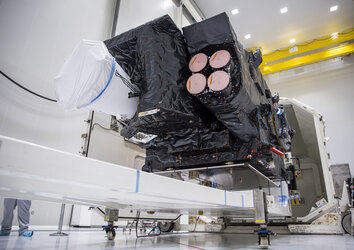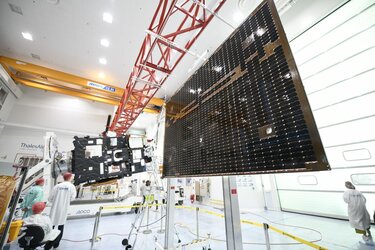Accept all cookies Accept only essential cookies See our Cookie Notice

About ESA
The European Space Agency (ESA) is Europe’s gateway to space. Its mission is to shape the development of Europe’s space capability and ensure that investment in space continues to deliver benefits to the citizens of Europe and the world.
Highlights
ESA - United space in Europe
This is ESA ESA facts Member States & Cooperating States Funding Director General Top management For Member State Delegations European vision European Space Policy ESA & EU Responsibility & Sustainability Annual Report Calendar of meetings Corporate newsEstablishments & sites
ESA Headquarters ESA ESTEC ESA ESOC ESA ESRIN ESA EAC ESA ESAC Europe's Spaceport ESA ESEC ESA ECSAT Brussels Office Washington OfficeWorking with ESA
Business with ESA ESA Commercialisation Gateway Law at ESA Careers Cyber resilience at ESA IT at ESA Newsroom Partnerships Merchandising Licence Education Open Space Innovation Platform Integrity and Reporting Administrative Tribunal Health and SafetyMore about ESA
History ESA Historical Archives Exhibitions Publications Art & Culture ESA Merchandise Kids Diversity ESA Brand Centre ESA ChampionsLatest
Space in Member States
Find out more about space activities in our 22 Member States, and understand how ESA works together with their national agencies, institutions and organisations.
Science & Exploration
Exploring our Solar System and unlocking the secrets of the Universe
Go to topicAstronauts
Missions
Juice Euclid Webb Solar Orbiter BepiColombo Gaia ExoMars Cheops Exoplanet missions More missionsActivities
International Space Station Orion service module Gateway Concordia Caves & Pangaea BenefitsLatest
Space Safety
Protecting life and infrastructure on Earth and in orbit
Go to topicAsteroids
Asteroids and Planetary Defence Asteroid danger explained Flyeye telescope: asteroid detection Hera mission: asteroid deflection Near-Earth Object Coordination CentreSpace junk
About space debris Space debris by the numbers Space Environment Report In space refuelling, refurbishing and removingSafety from space
Clean Space ecodesign Zero Debris Technologies Space for Earth Supporting Sustainable DevelopmentLatest
Applications
Using space to benefit citizens and meet future challenges on Earth
Go to topicObserving the Earth
Observing the Earth Future EO Copernicus Meteorology Space for our climate Satellite missionsCommercialisation
ESA Commercialisation Gateway Open Space Innovation Platform Business Incubation ESA Space SolutionsLatest
Enabling & Support
Making space accessible and developing the technologies for the future
Go to topicBuilding missions
Space Engineering and Technology Test centre Laboratories Concurrent Design Facility Preparing for the future Shaping the Future Discovery and Preparation Advanced Concepts TeamSpace transportation
Space Transportation Ariane Vega Space Rider Future space transportation Boost! Europe's Spaceport Launches from Europe's Spaceport from 2012Latest

RF model of MTG-I
Thank you for liking
You have already liked this page, you can only like it once!
This mesh-based model of Europe’s future Meteosat Third Generation Imager (MTG-I) satellite has helped select the optimal location of the radio frequency antennas used to send it commands and downlink mission telemetry.
The model gives engineers insights into the resulting radio frequency characteristics of the satellite itself. The colours indicate the induced electromagnetic response of adjacent surfaces when these antennas are active.
The red spot in the corner of the satellite body indicates the location of one of these S-band microwave antennas used for ‘telemetry, tracking and telecommand’, with another out of view on the satellite’s opposite side. The other colours show the resulting current across MTG-I, from orange on antenna-facing surfaces down to yellow, then green and finally the minimum intensity in blue.
This helps antenna engineers to calculate the ‘link budget’ or overall coverage and efficiency of these antennas in different positions, across both stowed and deployed configurations.
This model was prepared for MTG-I by ESA’s Antenna Computational Facilities (ACF), part of the Agency’s Antenna Test Facilities, based at its ESTEC technical centre in the Netherlands. Equipped with state-of-the-art software, the ACF solve complex electromagnetic problems across the entire radio spectrum in cooperation with European universities and industry.
Meteosat Third Generation, planned to enter service from 2021 onwards, will comprise four imaging and two sounding satellites. The latter, in a first for Europe, will carry an Infrared Sounder and Ultraviolet Visible Near-infrared Spectrometer, being provided by ESA to serve as the Copernicus Sentinel-4 mission.
-
CREDIT
ESA -
LICENCE
ESA Standard Licence and Additional permission may be required
(contact spaceinimages@esa.int for further information)

MTG-I1 antenna deployment

MTG-I1 looking good after voyage

Opening MTG-I1 container in the cleanroom

MTG-I1 in the cleanroom















 Germany
Germany
 Austria
Austria
 Belgium
Belgium
 Denmark
Denmark
 Spain
Spain
 Estonia
Estonia
 Finland
Finland
 France
France
 Greece
Greece
 Hungary
Hungary
 Ireland
Ireland
 Italy
Italy
 Luxembourg
Luxembourg
 Norway
Norway
 The Netherlands
The Netherlands
 Poland
Poland
 Portugal
Portugal
 Czechia
Czechia
 Romania
Romania
 United Kingdom
United Kingdom
 Sweden
Sweden
 Switzerland
Switzerland






















